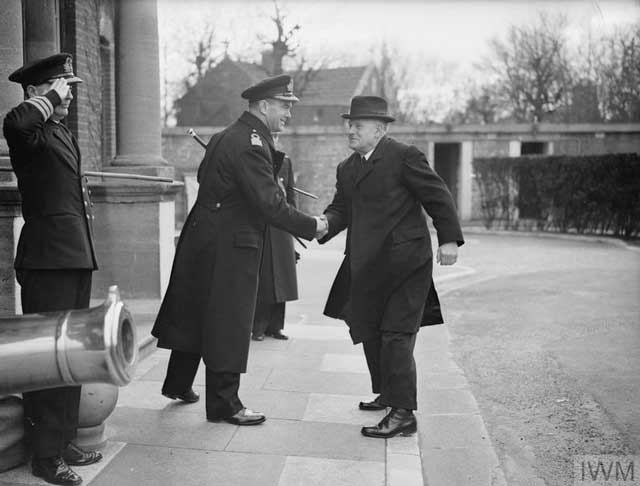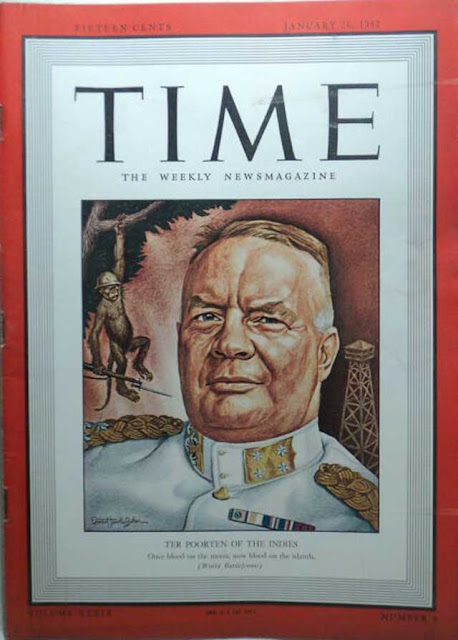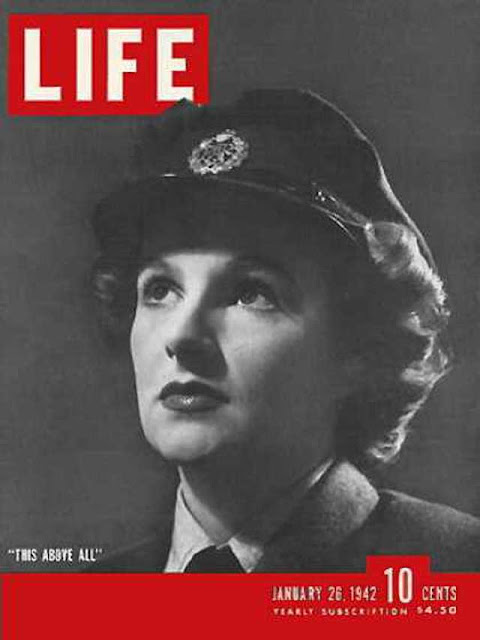Monday 26 January 1942
 |
| The first US troops in the European Theater of Operations disembark at Belfast, Northern Ireland, on 26 January 1942. |
Battle of the Pacific: On the Malay Peninsula, the Commonwealth troops continue to retreat south toward Singapore on 26 January 1942. A Japanese convoy of two ships lands troops at Endau, Malaya. Endau is a small town in Mersing District, Johor, Malaysia, which lies on the northern tip of east Johor, on the border with Pahang. The defense of Endau is critical to the defense of Singapore because it would sever lines of communication with British forces farther north. For this reason, it is a major objective of the Japanese military. These new Japanese troops put immediate pressure on the Allied defenders.
 |
| British Ten-pound banknotes issued by the Bank of Ireland in Northern Ireland, dated 26 January 1942, U/11 079069, with the signature of H.J. Adams |
Two Royal Australian Air Force (RAAF) Lockheed Hudson reconnaissance aircraft on routine patrol see the convoy of Japanese troopships (they report seeing eleven) heading from Cam Ranh Bay, Indochina, toward Endau. During the afternoon, the RAF sends 12 Vickers Vildebeest and 9 Fairey Albacore torpedo bombers of No. 36 Squadron RAF and No. 100 Squadron RAF to attack the force. The RAF planes are all biplanes and no match for defending Japanese fighters, and in any event, the planes arrive long after the landings have begun. They bomb the ships with "good results" according to the war diary.
 |
| "Studio portrait of NX33552 Private (Pte) Colin John Spence, 2/18 Battalion of Longueville, NSW (originally of Dunedin, NZ). On 26 January 1942 near Mersing in Malaya, a Japanese officer slashed Pte Spence with a sword, before Pte Spence killed the officer. Cut from his hip to his shoulder, Pte Spence required 150 stitches. He was then evacuated from Singapore on the last ship and admitted to hospital in Australia. Pte Spence was awarded the Distinguished Conduct Medal for the leadership he displayed." Australian War Memorial P04154.005. |
The RAF planes strafe the beach and bomb two Japanese transport ships at the cost of five Vildebeests (the Japanese lose one Ki-27). At dusk, the RAF sends a second wave of nine Vildebeests and three Albacores of No. 3 Squadron, but they fare little better, losing five Vildebeests, two Albacores, and a defending Hurricane fighter. The RAF then sends in another wave of attacks, this time by six unescorted Hudsons of No. 62 Squadron out of Palembang, Sumatra. Six Japanese Ki-27s set upon them and shoot two of them down. The RAF then sends off the fourth raid from Palembang, this time of five Bristol Blenheims of No. 27 Squadron, but it is too late and they turn back. While the RAF attacks demonstrate how seriously the British view the invasion, they accomplish nothing of value and the Japanese troops secure their lodgement areas. The British have not given up, however, and send two destroyers (HMS Thanet and HMAS Vampire) from Singapore to try to disrupt the landings. However, the ships do not arrive until early on the 27th.
 |
| "Arriving: Private Milburn Henke, who was presented to the press as the 'first' United States soldier to step ashore, salutes as he lands at Dufferin Quay, Belfast, Northern Ireland. In reality, a whole contingent of GIs had come ashore without distinguished reception." © IWM (H 16847). |
In the Philippines, the Allied troops are in disarray and trying to find a defensible line. Both the I Corps and II Corps complete their withdrawal to the final defense line in the Bataan Peninsula, but it gives the American and Philippine troops no relief. The Japanese follow close behind. The main Allied advantage is that the Peninsula narrows as they retreat south, and it now is possible to form a complete line from coast to coast. This extends from Orion in the east to Bagac on the west coast, just to the south of the Pilar-Bagac road. The entire Allied military organization is revised, and the Headquarters, US Army Forces, Far East (USAFFE) take advantage of the shortened line by taking the Philippine Division out of the line and putting it in reserve. The Japanese begin heading south on the West Road, with every step contested by the 91st Filipino Division. Further south, the Japanese keep their beachheads at Quinauan and Longoskawayan Points despite frantic Allied attacks that cause heavy casualties on both sides.
 |
| A US GI and a British Tommy shake hands as the first US troops arrive in Europe at Belfast, Northern Ireland, on 26 January 1942 (Life magazine). |
At Balikpapan, Borneo, the Japanese complete the capture of the City of Balikpapan and the surrounding area. This is the most economically significant success of the entire Japanese offensive to date, as the Balikpapan refinery is projected to provide almost a third of all Japanese oil requirements.
 |
| "Mr. W.J. Jordan, the High Commissioner for New Zealand, being greeted by the Commodore of the Royal Naval Barracks, Portsmouth, Captain E R Archer, RN, on his arrival at Portsmouth." 26 January 1942. © IWM (A 7228). |
In Burma, Allied defenses near Moulmein on the Salween River in the eastern part of the country are under great strain. The main fight in the air is much further west, over Rangoon. Today, American Volunteer Group (AVG or "Flying Tigers") fighters of the 1st and 2nd Fighter Squadrons put up a stout defense over the capital, shooting down three Japanese Army fighters.
 |
| "Ter Poorten of the Indies" is the cover story of the 26 January 1942 Time magazine. Hein ter Poorten is the Allied land forces commander in the American-British-Dutch-Australian Command on Java in January 1942. |
The Allied Command (ABDA) is determined to defend the Netherlands East Indies, but they have to transfer troops from the Middle East to have any hope of that. The Australian government is understandably leery about the Japanese wave heading south toward them, so the British are transferring Australian troops from the North African front. Lieutenant General Sir John Lavarack, General Officer Commanding I Australian Corps, arrives
 |
| US Army officers Major General Chaney and Major General Hartle, in command of the troops arriving at Belfast, Northern Ireland on 26 January 1942. |
Battle of the Mediterranean: The attack by Afrika Korps is held up by a fierce sandstorm. Behind the scenes on the Allied side, there is a flurry of activity as the Allied leaders try to digest the latest successes by the Germans in North Africa. General Sir Claude Auchinleck, Commander-in-Chief, Middle East, sends a telegram to Winston Churchill in which he notes that the British line has been pushed back and that he is in the process of evacuating Benghazi. General Sir Thomas Blamey, Deputy Commander-in-Chief, Middle East, the top Australian military official in the Middle East, sends Churchill a separate telegram indicating that Commonwealth forces have had to retreat in the vicinity of Antelat, Libya. Churchill is very put out by all of these developments and views the retreats as implying the "failure of Crusader and the ruin of Acrobat," which are the codenames for the recent operation that relieved Tobruk and a separate operation being considered against Tripoli. Everyone knows that the situation is unlikely to improve anytime soon because Australian and New Zealand troops need to return home to defend Australia.
 |
| The first US GIs arriving in Europe at Belfast, Northern Ireland, on 26 January 1942. Note that the troops wear the standard Word War I helmets. |
Eastern Front: The Stavka decides to increase its pressure on General Hermann Hoth's 17th Army, holding a stretch of the front on the Mius River northwest of Rostov. Marshal Timoshenko orders Ninth Army to join the attack alongside 57th Army. As with all of the Soviet offensive, the Red Army men are pushing the Wehrmacht troops back but not capturing much aside from forests and fields. The Soviet plan is to get behind the main German line on the river and then pivot to the south. This, Timoshenko hopes, will leverage the Germans off the entire Mius River line by threatening to cut them off when they reach the coast between Mariupol and Melitopol. On the German side, General Ewald von Kleist sees the danger and begins moving in from the south the 14th Panzer Division, the 100th Light Division, and Panzer Detachment 60. This force is called the "von Mackensen Group" after its commander, General von Mackensen, commander of III Panzer Corps. It has to battle fierce snowstorms to get into position, but the weather also slows down the Red Army attacks and this situation becomes a mixed blessing for both sides. Von Kleist also orders the very weak XI Corps to march west via Dnepropetrovsk. The importance of these ad hoc commands is growing on the German side because of the huge losses many units have taken. Disparate units that are the remnants of once-imposing units have to be cobbled together to form larger groupings from whatever odds and ends are in the vicinity. This is the only way to blunt the incessant Soviet attacks.
 |
| US troops arriving at Belfast, Northern Ireland, on 26 January 1942. |
Western Front: Under great secrecy, the first US soldiers arrive at Belfast, Northern Ireland to take up posts in the European Theater of Operations. They are members of the 133rd Infantry Regiment, 34th Division. About 4,000 men arrive in order to honor the "Germany First" principle agreed to at the Arcadia Conference in early January 1942.
British/New Zealand Relations: The Australians are not the only ones watching the Japanese approach with trepidity. On 26 January 1942, the Government of New Zealand sends British Prime Minister Winston Churchill a telegram requesting confirmation that New Zealand would have a voice at the Far East Council and influence over the affairs of the Australian and New Zealand Army Corps (ANZAC) troops. New Zealand also emphasizes that it requires direct communications on its own with the United States, which everyone realizes is the only Allied force in the Pacific capable of stopping the Japanese.
British Military: General Sir Archibald Wavell, Supreme Commander, South West Pacific, replies to a pointed inquiry from Winston Churchill about relations with China. Wavell denies that he has refused Chinese help and states that he has accepted the 49th and 93rd Chinese Divisions. Relations between China and the UK have been frayed since the Tulsa Incident in late December when local British authorities in Rangoon tried to divert US Lend-Lease supplies destined for China to British troops. Wavell does, however, note that it would be better to defend Burma with British troops rather than risk losing larger portions of China to the Japanese. Both men agree that British relations with China are extremely poor.
 |
| The 26 January 1942 Life magazine cover story is about the Women s Auxiliary Air Force ("WAAF"). |
1942
January 1942
January 1, 1942: Declaration By United Nations
January 2, 1941: Manila Falls to Japan
January 3, 1942: ABDA Command Announced
January 4, 1942: MacArthur on His Own in the Philippines
January 5, 1942: Soviets Plan General Offensive
January 6, 1942: US Army in Europe
January 7, 1942: Soviet General Offensive Opens
January 8, 1942: Hitler Sacks Hoepner
January 9, 1942: Battle of Dražgoše
January 10, 1942: Building the Jeep
January 11, 1942: Japan Takes Kuala Lumpur
January 12, 1941: Rommel Plans Counterattack
January 13, 1942: First Ejection Seat Use
January 14, 1942: Operation Drumbeat First Sinking
January 15, 1942: U-Boat Off NYC
January 16, 1942: Carole Lombard Crash
January 17, 1942: British Take Halfaya Pass
January 18, 1942: Soviet Paratroopers in Action
January 19, 1942: FDR Approves Atomic Bomb
January 20, 1942: The Wannsee Conference
January 21, 1942: Parit Sulong Bridge Battle
January 22, 1942: Parit Sulong Massacre
January 23, 1942: Japan Takes Rabaul
January 24, 1942: Battle of Makassar Strait
January 25, 1942: Kholm Surrounded
January 26, 1942: GIs Land in Europe
January 27, 1942: Battle of Endau
January 28, 1942: Rommel Takes Benghazi
January 29, 1942: First US Coast Guard Ship Sunk
January 30, 1942: Singapore Isolated
January 31, 1942: Army Group South Averts Disaster
2020











No comments:
Post a Comment